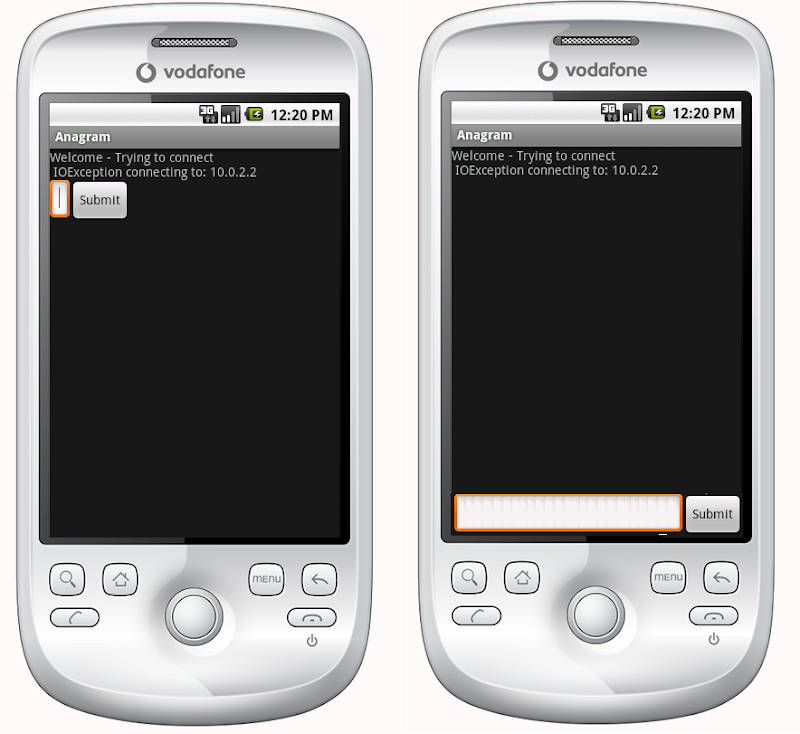提问人:gav 提问时间:3/5/2010 最后编辑:Peter Mortensengav 更新时间:9/24/2019 访问量:622490
如何对齐屏幕底部的视图?
How do I align views at the bottom of the screen?
问:
这是我的布局代码;
<?xml version="1.0" encoding="utf-8"?>
<LinearLayout xmlns:android="http://schemas.android.com/apk/res/android"
android:orientation="vertical"
android:layout_width="fill_parent"
android:layout_height="fill_parent">
<TextView android:text="@string/welcome"
android:id="@+id/TextView"
android:layout_width="fill_parent"
android:layout_height="wrap_content">
</TextView>
<LinearLayout android:id="@+id/LinearLayout"
android:orientation="horizontal"
android:layout_width="wrap_content"
android:layout_height="wrap_content"
android:gravity="bottom">
<EditText android:id="@+id/EditText"
android:layout_width="fill_parent"
android:layout_height="wrap_content">
</EditText>
<Button android:text="@string/label_submit_button"
android:id="@+id/Button"
android:layout_width="wrap_content"
android:layout_height="wrap_content">
</Button>
</LinearLayout>
</LinearLayout>
左边是左边,右边是我希望它的样子。

显而易见的答案是将 TextView 设置为高度fill_parent,但这会导致没有空间留给按钮或输入字段。
从本质上讲,问题在于我希望提交按钮和文本条目在底部是固定高度,而文本视图则填充其余空间。同样,在水平线性布局中,我希望提交按钮包装其内容,并让文本条目填充其余空间。
如果告诉线性布局中的第一个项目fill_parent它就会这样做,不会为其他项目留出空间。如何让线性布局中第一个项目填充除布局中其余项目所需的最小空间之外的所有空间?
相对布局确实是答案:
<?xml version="1.0" encoding="utf-8"?>
<RelativeLayout
xmlns:android="http://schemas.android.com/apk/res/android"
android:layout_width="fill_parent"
android:layout_height="fill_parent">
<TextView
android:text="@string/welcome"
android:id="@+id/TextView"
android:layout_width="fill_parent"
android:layout_height="wrap_content"
android:layout_alignParentTop="true">
</TextView>
<RelativeLayout
android:id="@+id/InnerRelativeLayout"
android:layout_width="wrap_content"
android:layout_height="wrap_content"
android:layout_alignParentBottom="true" >
<Button
android:text="@string/label_submit_button"
android:id="@+id/Button"
android:layout_alignParentRight="true"
android:layout_width="wrap_content"
android:layout_height="wrap_content">
</Button>
<EditText
android:id="@+id/EditText"
android:layout_width="fill_parent"
android:layout_toLeftOf="@id/Button"
android:layout_height="wrap_content">
</EditText>
</RelativeLayout>
</RelativeLayout>
答:
执行此操作的新式方法是使用 ConstraintLayout,并使用 app:layout_constraintBottom_toBottomOf=“parent” 将视图的底部约束到 ConstraintLayout 的底部
下面的示例创建一个 FloatingActionButton,它将与屏幕的末尾和底部对齐。
<android.support.constraint.ConstraintLayout
xmlns:android="http://schemas.android.com/apk/res/android"
xmlns:app="http://schemas.android.com/apk/res-auto"
xmlns:tools="http://schemas.android.com/tools"
android:layout_height="match_parent"
android:layout_width="match_parent">
<android.support.design.widget.FloatingActionButton
android:layout_height="wrap_content"
android:layout_width="wrap_content"
app:layout_constraintBottom_toBottomOf="parent"
app:layout_constraintEnd_toEndOf="parent" />
</android.support.constraint.ConstraintLayout>
作为参考,我将保留我的旧答案。
在引入 ConstraintLayout 之前,答案是相对布局。
如果你有一个填满整个屏幕的相对布局,你应该能够使用 android:layout_alignParentBottom 将按钮移动到屏幕底部。
如果底部的视图未以相对布局显示,那么它上面的布局可能会占用所有空间。在这种情况下,您可以将视图(应位于底部)放在布局文件中的第一位,然后将布局的其余部分放在视图上方。这使底部视图能够根据需要占用尽可能多的空间,并且布局的其余部分可以填充屏幕的所有其余部分。android:layout_above
评论
android:layout_above
that RelativeLayout
您甚至不需要将第二个布局嵌套在第一个布局中。只需在 Button 和 EditText 中使用即可。relativeandroid:layout_alignParentBottom="true"
评论
这在 这是行不通的,因为 会重叠页面底部的任何内容。ScrollViewRelativeLayoutScrollView
我使用动态拉伸修复了它:FrameLayout
<ScrollView
xmlns:android="http://schemas.android.com/apk/res/android"
android:layout_height="match_parent"
android:layout_width="match_parent"
android:fillViewport="true">
<LinearLayout
android:id="@+id/LinearLayout01"
android:layout_width="match_parent"
android:layout_height="match_parent"
xmlns:android="http://schemas.android.com/apk/res/android"
android:orientation="vertical">
<!-- content goes here -->
<!-- stretching frame layout, using layout_weight -->
<FrameLayout
android:layout_width="match_parent"
android:layout_height="0dp"
android:layout_weight="1">
</FrameLayout>
<!-- content fixated to the bottom of the screen -->
<LinearLayout
android:layout_width="match_parent"
android:layout_height="wrap_content"
android:orientation="horizontal">
<!-- your bottom content -->
</LinearLayout>
</LinearLayout>
</ScrollView>
评论
上面的答案(由 Janusz 提供)非常正确,但我个人对 RelativeLayouts 并不感到 100% 舒适,所以我更喜欢引入一个“填充物”,空的 TextView,如下所示:
<!-- filler -->
<TextView android:layout_height="0dip"
android:layout_width="fill_parent"
android:layout_weight="1" />
在应该在屏幕底部的元素之前。
评论
您可以通过将相对布局嵌套在线性布局中来保留初始线性布局:
<LinearLayout
android:orientation="vertical"
android:layout_width="fill_parent"
android:layout_height="fill_parent">
<TextView android:text="welcome"
android:id="@+id/TextView"
android:layout_width="fill_parent"
android:layout_height="wrap_content">
</TextView>
<RelativeLayout
android:layout_width="match_parent"
android:layout_height="match_parent">
<Button android:text="submit"
android:id="@+id/Button"
android:layout_width="wrap_content"
android:layout_height="wrap_content"
android:layout_alignParentBottom="true"
android:layout_alignParentRight="true">
</Button>
<EditText android:id="@+id/EditText"
android:layout_width="match_parent"
android:layout_height="wrap_content"
android:layout_toLeftOf="@id/Button"
android:layout_alignParentBottom="true">
</EditText>
</RelativeLayout>
</LinearLayout>
评论
如果你不想做很多改变,那么你可以把:
android:layout_weight="1"
对于 ID 为 的 TextView,即@+id/TextView
<TextView android:text="@string/welcome"
android:id="@+id/TextView"
android:layout_width="fill_parent"
android:layout_height="wrap_content"
android:layout_weight="1">
</TextView>
评论
这也有效。
<LinearLayout
android:id="@+id/linearLayout4"
android:layout_width="wrap_content"
android:layout_height="fill_parent"
android:layout_below="@+id/linearLayout3"
android:layout_centerHorizontal="true"
android:orientation="horizontal"
android:gravity="bottom"
android:layout_alignParentBottom="true"
android:layout_marginTop="20dp"
>
<Button
android:id="@+id/button1"
android:layout_width="wrap_content"
android:layout_height="wrap_content"
android:text="Button"
/>
<Button
android:id="@+id/button2"
android:layout_width="wrap_content"
android:layout_height="wrap_content"
android:text="Button"
/>
</LinearLayout>

评论
我使用了 Janusz 发布的解决方案,但我在最后一个视图中添加了填充,因为我的布局的顶部是 ScrollView。
随着内容的增长,ScrollView 将被部分隐藏。在最后一个视图上使用有助于显示 ScrollView 中的所有内容。android:paddingBottom
您也可以使用 LinearLayout 或 ScrollView 执行此操作。有时它比 RelativeLayout 更容易实现。您唯一需要做的就是在要对齐到屏幕底部的视图之前添加以下视图:
<View
android:layout_width="wrap_content"
android:layout_height="0dp"
android:layout_weight="1" />
这将创建一个空视图,填充空白空间并将下一个视图推送到屏幕底部。
评论
在您的 .android:layout_alignParentBottom="true"<RelativeLayout>
这肯定会有所帮助。
评论
这也可以通过线性布局来完成。
只需为上面的布局提供高度 = 0dp 和重量 = 1 并在底部提供您想要的布局。只需写高度 = 包装内容,没有重量。
它为布局(包含编辑文本和按钮的布局)提供换行内容,然后具有权重的布局占据布局的其余部分。
我是偶然发现的。
使用以下代码。将按钮对准 buttom。它正在工作。
<?xml version="1.0" encoding="utf-8"?>
<LinearLayout xmlns:android="http://schemas.android.com/apk/res/android"
android:layout_width="match_parent"
android:layout_height="match_parent"
android:orientation="vertical" >
<Button
android:id="@+id/btn_back"
android:layout_width="100dp"
android:layout_height="80dp"
android:text="Back" />
<TextView
android:layout_width="match_parent"
android:layout_height="0dp"
android:layout_weight="0.97"
android:gravity="center"
android:text="Payment Page" />
<LinearLayout
android:layout_width="match_parent"
android:layout_height="wrap_content" >
<EditText
android:layout_width="wrap_content"
android:layout_height="wrap_content"
android:layout_weight="1"/>
<Button
android:layout_width="wrap_content"
android:layout_height="wrap_content"
android:text="Submit"/>
</LinearLayout>
</LinearLayout>
如果您有这样的层次结构:
<ScrollView>
|-- <RelativeLayout>
|-- <LinearLayout>
首先,应用到 ,然后应用到 .android:fillViewport="true"ScrollViewandroid:layout_alignParentBottom="true"LinearLayout
这对我来说非常有效。
<ScrollView
android:layout_height="match_parent"
android:layout_width="match_parent"
android:scrollbars="none"
android:fillViewport="true">
<RelativeLayout
android:layout_width="match_parent"
android:layout_height="wrap_content">
<LinearLayout
android:orientation="horizontal"
android:layout_width="match_parent"
android:layout_height="wrap_content"
android:gravity="center"
android:id="@+id/linearLayoutHorizontal"
android:layout_alignParentBottom="true">
</LinearLayout>
</RelativeLayout>
</ScrollView>
创建页眉和页脚,下面是一个示例:
布局 XML
<RelativeLayout
xmlns:android="http://schemas.android.com/apk/res/android"
xmlns:tools="http://schemas.android.com/tools"
android:layout_width="fill_parent"
android:layout_height="fill_parent"
android:background="@color/backgroundcolor"
tools:context=".MainActivity">
<RelativeLayout
android:layout_width="fill_parent"
android:layout_height="40dp"
android:background="#FF0000">
</RelativeLayout>
<RelativeLayout
android:layout_width="fill_parent"
android:layout_height="40dp"
android:layout_alignParentBottom="true"
android:background="#FFFF00">
</RelativeLayout>
</RelativeLayout>
截屏

对于此类情况,请始终使用 RelativeLayouts。LinearLayout 不适用于此类用途。
<?xml version="1.0" encoding="utf-8"?>
<RelativeLayout
xmlns:android="http://schemas.android.com/apk/res/android"
android:id="@+id/db1_root"
android:layout_width="match_parent"
android:layout_height="match_parent"
android:orientation="vertical" >
<LinearLayout
android:layout_width="match_parent"
android:layout_height="match_parent"
android:orientation="vertical">
<!-- Place your layout here -->
</LinearLayout>
<LinearLayout
android:layout_width="match_parent"
android:layout_height="wrap_content"
android:layout_alignParentBottom="true"
android:layout_gravity="bottom"
android:orientation="horizontal"
android:paddingLeft="20dp"
android:paddingRight="20dp" >
<Button
android:id="@+id/setup_macroSavebtn"
android:layout_width="0dp"
android:layout_height="wrap_content"
android:layout_weight="1"
android:text="Save" />
<Button
android:id="@+id/setup_macroCancelbtn"
android:layout_width="0dp"
android:layout_height="wrap_content"
android:layout_weight="1"
android:text="Cancel" />
</LinearLayout>
</RelativeLayout>
继 Timores 的优雅解决方案之后,我发现以下内容在垂直 LinearLayout 中创建垂直填充,在水平 LinearLayout 中创建水平填充:
<Space
android:layout_width="match_parent"
android:layout_height="match_parent"
android:layout_weight="1" />
评论
您可以只为顶部子视图(TextView @+id/TextView)提供一个属性:.android:layout_weight="1"
这将迫使其下方的所有其他元素都位于底部。
1. 在根布局中使用ConstraintLayout
并设置为让屏幕底部的布局:app:layout_constraintBottom_toBottomOf="parent"
<LinearLayout
android:id="@+id/LinearLayout"
android:layout_width="match_parent"
android:layout_height="wrap_content"
android:orientation="horizontal"
app:layout_constraintBottom_toBottomOf="parent">
</LinearLayout>
2. 在根布局中使用FrameLayout
只需设置在您的布局中android:layout_gravity="bottom"
<LinearLayout
android:id="@+id/LinearLayout"
android:layout_width="match_parent"
android:layout_height="wrap_content"
android:layout_gravity="bottom"
android:orientation="horizontal">
</LinearLayout>
3. 在根布局中使用 (LinearLayoutandroid:orientation="vertical")
(1) 在你的布局顶部设置一个布局android:layout_weight=“1”
<TextView
android:id="@+id/TextView"
android:layout_width="match_parent"
android:layout_height="0dp"
android:layout_weight="1"
android:text="welcome" />
(2) 为 android:layout_width=“match_parent” android:layout_height=“match_parent” android:gravity=“bottom” 设置子 LinearLayout
main 属性是 ,让子 View 放在 Layout 的底部。ndroid:gravity="bottom"
<LinearLayout
android:id="@+id/LinearLayout"
android:layout_width="match_parent"
android:layout_height="match_parent"
android:gravity="bottom"
android:orientation="horizontal">
</LinearLayout>
4. 在根布局中使用RelativeLayout
并设置为让布局在屏幕底部android:layout_alignParentBottom="true"
<LinearLayout
android:id="@+id/LinearLayout"
android:layout_width="match_parent"
android:layout_height="wrap_content"
android:layout_alignParentBottom="true"
android:orientation="horizontal">
</LinearLayout>

评论